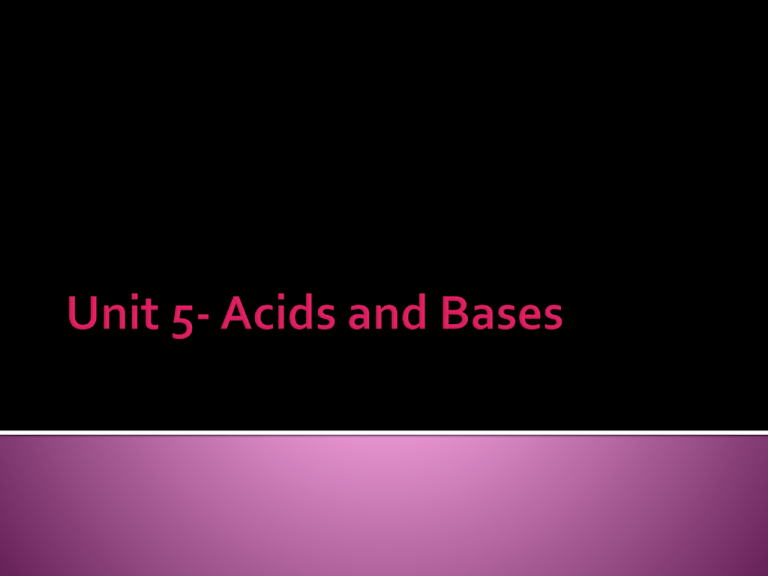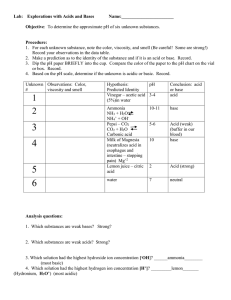Unit 5- Acids and Bases
advertisement

It shouldn't be hard for you to name several common acids, but you might find that listing bases is just a little more difficult. Here's a partial list of some common acids and bases, along with some chemical formulas: Some Common Acids Some Common Bases hydrochloric acid, HCl (stomach acid) sodium hydroxide, NaOH (lye or caustic soda) sulfuric acid, H2SO4 potassium hydroxide, KOH (lye or caustic potash) nitric acid, HNO3 (milk of magnesia) magnesium hydroxide, Mg(OH)2 carbonic acid, H2CO3 acetic acid, HC2H3O2 (vinegar) formic acid, HCOOH calcium hydroxide, Ca(OH)2 (slaked lime) citric acid, C6H8O7 ammonia, NH3 acetylsalicylic acid, commonly known as aspirin C6H4(OCOCH3)CO2H Acids and bases have characteristic properties. You'll want to learn this list. Key Characteristics of Acids sour taste (e.g. lemons; vinegar; sour milk)grapefruit; react with active metals such as zinc and magnesium to produce hydrogen gas form electrolytic solutions (conduct electricity) because they produce ions cause certain dyes to change color; litmus paper turns red, for example Key Characteristics of Bases bitter taste generally no noticeable reaction with active metals form electrolytic solutions (conduct electricity) because they produce ions cause certain dyes to change color; litmus paper turns blue for example slippery feel (e.g. soapy feel) neutralized by bases neutralized by acids (neutralized means that the substance no longer has acidic, or basic, properties) Acids all have one thing in common, and most bases have another the properties of acids were due to the presence of hydrogen ions, H+, and the properties of bases were due to the presence of hydroxide ions, OH-. An important aspect is that these compounds only become acid or bases when in solution. We need to examine what happens when we add them to water that suddenly produces either acidic or basic properties. Lab 5.1.2 Recall: electrolytic solutions are those that conduct electricity because the substance dissolves in water to produce ions. Solutions that conduct electricity well are strong electrolytes –because they break down well and produce many ions in solution. Weak electrolytes do not conduct electricity and have fewer ions are produced in solution. Ionic compounds and some molecular compounds can produce electrolytic solutions, in a process called dissociation Dissociation of ionic compounds occurs when water molecules “pull apart” the ionic crystal because of strong attractions between the polar ends of the water molecule and the positive and negative ions within the crystal. Water molecules then surround the cations and anions; called hydration NaCl(s) → Na+(aq) + Cl-(aq) Na2SO4 (s) → 2 Na+(aq) + SO42-(aq) (NH4)3PO4 (s) → 3 NH4+(aq) + PO43-(aq) NaOH(s) → Na+(aq) + OH– (aq) KOH(s) → K+(aq) + OH– (aq) Mg(OH)2 (s) → Mg2+(aq) + 2 OH– (aq) all three of the last reactions produce hydroxide ions, OH– and are Arrhrenius bases since they produce hydroxide ions in solution. There are two important things to notice about writing dissociation equations: 1. Generally DO NOT include H2O as a reactant. There are some exceptions to this rule. 2. Ion charges MUST BE included! An ion, such as the sodium ion Na+ is not the same as a sodium atom, Na. Refer to your Table of Common Ions if needed. When molecular compounds dissolve in water to produce ions the process is typically called ionization. Recall that molecular compounds are held together by covalent bonding; ionic compounds are held together by ionic bonding Most molecular compounds do not undergo ionization. Acids are an exception. All acids produce hydrogen ions in solution. Some examples: HCl (g)→ H+(aq) + Cl-(aq) H2SO4 (g)→ 2 H+(aq) + SO42-(aq) These are actually simplified versions of the actual equations: HCl(g) + H2O(l) → H3O+(aq) + Cl-(aq) H2SO4 (g) + H2O(l)→ 2 H3O+(aq) + SO42-(aq) it won't make a difference which way you write the reactions, for our purposes they will represent the same thing. Note: an Arrhenius base was defined as a substance that produces hydroxide ions in solution. But remember ammonia, NH3???? How can it be a base? It is a general theory that has some exceptions such as ammonia That lack of an OH- group in ammonia is a bit of a problem at first glance, but let's take a closer look at what happens when NH3 is added to water: NH3 (g) + H2O(l) NH4+(aq) + OH–(aq) This is known as the Brønsted-Lowry theory of acids and bases can be stated as follows: Acids are substances that produce a hydrogen ion (or a proton donor) Bases are substances that can accept a hydrogen ion (or a proton acceptor) Using hydrochloric acid as an example, consider how HCl acts as an acid: HCl (g)→ H+(aq) + Cl-(aq) or HCl(g) + H2O(l) → H3O+(aq) + Cl-(aq) When something is donated, something else will receive it. It's not obvious in the top reaction, but it is water, H2O, that accepts the hydrogen. This is how an acid can act as a proton donor - it gives away it's hydrogen ion to a water molecule. View an animation of how HCl acts as an acid Let's take a closer look at how a base can "accept a hydrogen ion". Our ammonia example does a good job of showing this: NH3 (g) + H2O(l) NH4+(aq) + OH–(aq) The ammonium ion, NH4+, was formed when ammonia accepted a hydrogen ion. This makes ammonia a base. The +1 charge results because the ammonium ion has lost one electron. The H2O changes to OH– after giving up it's H+ View an animation of how NH3 acts as a base Conjugate acid-base pairs differ from each other by the presence or absence of a single hydrogen ion (proton). Every acid has a conjugate base, and every base has a conjugate acid. The conjugates will always be listed on the product side of the reaction. Substances that can act as an acid is one reaction and as a base in another are called amphoteric substances Example: In the first reaction the bisulfate ion, HSO4– acts as a base. In the second reaction it acts as an acid: 1. HSO4– + H3O+ ↔ H2SO4 + H2O HSO4– accepts a proton from H3O+ 2. HSO4– + OH– ↔ H2O + SO42HSO4– gives (donates) a proton to OH – Practice Problems 5.1.6 Are acids that contain more than one hydrogen ion that can be lost. Example: Sulfuric acid, H2SO4 has two hydrogen ions that it can give up. The first hydrogen ion is released as: H2SO4 (aq) → H+(aq) + HSO4-(aq) The second hydrogen will be more difficult to remove because it must now be removed from a negative ion, HSO4-. HSO4-(aq) → H+(aq) + SO42-(aq) Acids that can donate more than one hydrogen ion are called polyprotic How many H+ can citric acid, H3C6H5O7, release? What do you think the equations describing the release of the H+ will be? Citric acid can release three H+. The reactions would be: 1. H3C6H5O7 (aq) → H+(aq) + H2C6H5O7-(aq) 2. H2C6H5O7-(aq) → H+(aq) + HC6H5O72-(aq) 3. HC6H5O72-(aq) → H+(aq) + C6H5O73-(aq) Assignment 5.1.7







